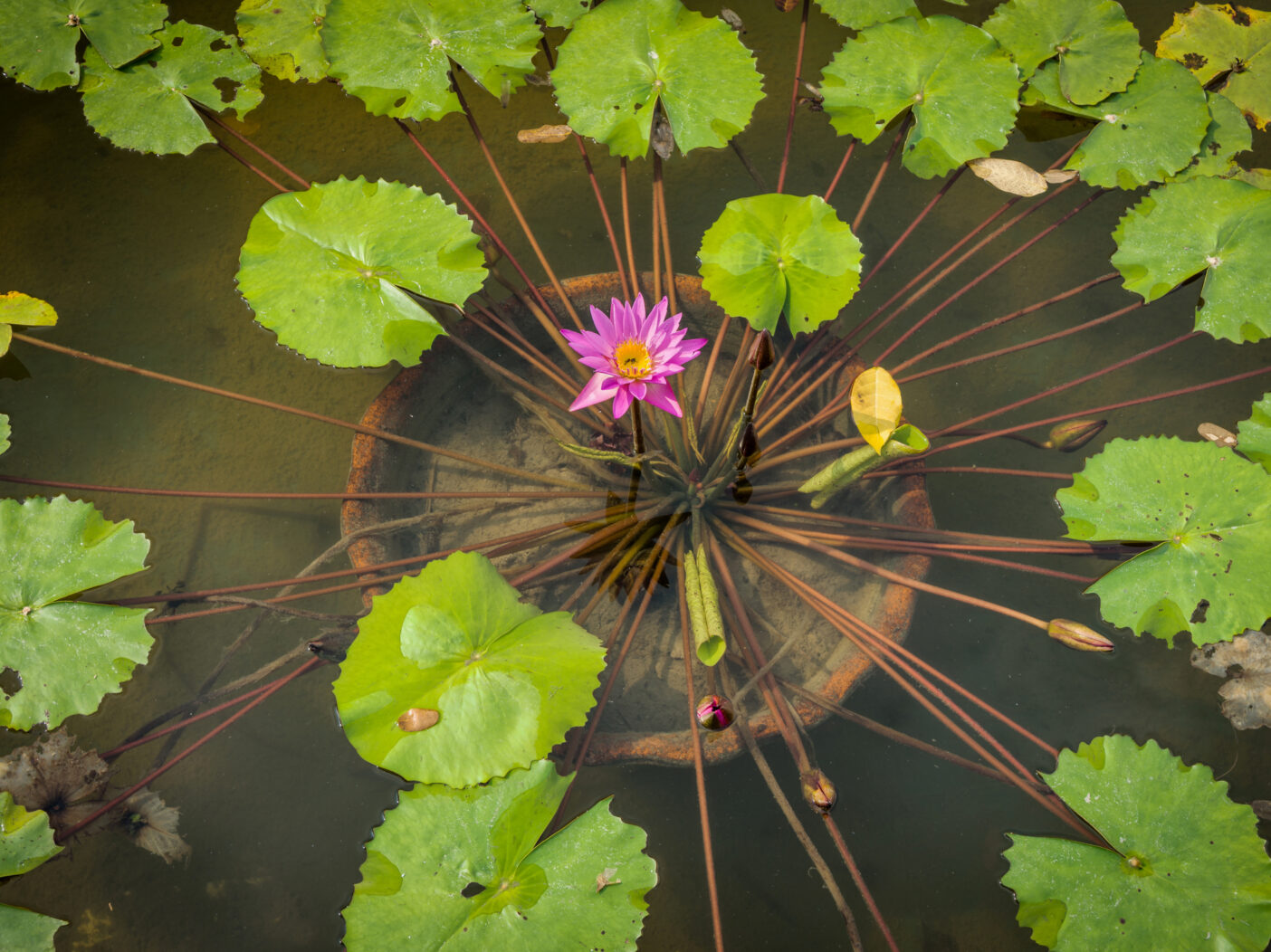
Dive into this primer with Aquatic Areas Manager Kathy Cahill, and learn how to create your own waterborne utopia.
There’s a certain mystique about waterlilies, those stretching, arching dollops of color emerging from the water’s surface.
You can admire myriad species within the family Nymphaea dotting more than 60,000 square feet of water features during any given Garden visit. While we enjoy the beauty above the water, Kathy is concerned with what goes on beneath the surface. Have you ever wondered what it takes to grow a water garden?

The setup is surprisingly simple: a combination of Florida topsoil, aquatic fertilizer, and, for the pot: “We’ll plant in a milk crate lined with burlap, so roots can eventually escape,” she says.
Not every public garden opts to grow its waterlilies this way.
“We keep everything in pots, so they don’t grow wild,” she says. “Once you put them in the ground, it’s a whole other ball game.” In the Garden, where most of our water features are lined in concrete, planting them or tying these plants to a rock and letting them grow unabated simply isn’t an option, especially since there is no soil to serve as anchor.
Kathy’s growing process starts with tubers.
“Most tropical waterlilies — the majority of our collection — throw off tubers,” Kathy explains. She places each one, similar in shape to a large walnut, into a zipclose bag ballooning with water. It’s all the plant needs to germinate and sprout lily pads and roots.
Once planted, staff get in the water once a week to clean leaves and deadhead (remove) spent blooms. Repotting is a biannual affair.
For those of us wishing for a similar ambience at home, we can recreate on a small scale what the Garden does en masse, Kathy says.
1. Do your homework.
Research the waterlilies and plants you want to grow. How big will the plants get? I recommend a little research into your plants’ normal growth habits, and then experimentation; plants.iwgs.org and victoria-adventure.org are trustworthy, beginner-friendly sites full of great information.
2. Find the vessel that fits the plants.
You can use almost anything: aquariums, wood barrels, metal tubs, and more. As a general rule, aquatic plants grow to the size of their container, unless you get a larger one to accommodate them.
3. Waterproof your vessel.
Make sure it will hold water.
4. Plan your location.
Prepare everything exactly where you want it to stay (no water-sloshing, post-planting relocation here). Waterlilies need bright light to thrive, but many aquatic marginal plants do well in shade.
5. Buy your plants.
Look for plants at your local nursery, or purchase online. The International Waterlily & Water Gardening Society website, iwgs.org, lists commercial members, many of which will ship to your door.
6. Pot your plants.
You can use milk crates like we do if your pool or decorative pot is large enough to accommodate, or use regular terra cotta or plastic plant pots. You may use potting soil, but avoid perlite, vermiculite, or anything that floats. Never bury the crowns of the plants.
7. Feed your plants.
Put some aquatic plant fertilizer in the pot. Look for products labeled specifically this way, and follow the manufacturer’s directions.
8. Place waterlilies at the correct height.
Waterlilies will grow as long as the crown is submerged, but generally prefer a depth of 18 to 24 inches. Set the potted waterlilies at the bottom of your decorative container.
9. Accent your plants.
Add marginal aquatic plants, also known as pond plants, such as taro, alligator
flag, or canna lilies. Even these, which eventually can grow quite large, can be grown in decorative pots for a season. They are called marginal plants because they like to be placed closer to the water’s surface, going with the ebb and flow. Like any landscape design, you want to have something tall, and something that cascades.
10. Tend your plants.
You can’t just fill your aquatic container garden once and walk away. Refresh the water, and maintain the plants with deadheading.
11. Enjoy your aquatic container garden, and remember, it’s a matter of trial and error. If your plants are grumpy, try again. It’s just like any type of gardening.
Keeping mosquitos at bay
Consider adding fish to the water. If you don’t want to be responsible for an entire micro-ecosystem, you can add mosquito dunk tablets instead.
Tips for Northern gardeners
Opt for hardy waterlilies. Many can make it through the winter, depending on your location and their level of hardiness.
For your marginal aquatic plants, take them out of the container, cut them back, and put them in a dark spot in your home (a garage or basement works well).
Keep these dormant plants from completely desiccating by adding some water once in a while. In spring, take them back out, divide as you like, and resubmerge. With luck, they’ll grow again.
This article originally appeared in the Spring/Summer issue of Cultivate, the Garden’s magazine.
About the Authors
 Kathy Cahill is the Garden’s Aquatic Areas Manager.
Kathy Cahill is the Garden’s Aquatic Areas Manager.
 Jenny Fuentes is the Senior Content Manager at Naples Botanical Garden.
Jenny Fuentes is the Senior Content Manager at Naples Botanical Garden.

